|
|
|
Sort Order |
|
|
|
Items / Page
|
|
|
|
|
|
|
| Srl | Item |
| 1 |
ID:
139789
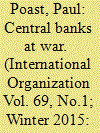

|
|
|
|
|
| Summary/Abstract |
War is expensive—troops must be equipped and weapons must be procured. When the enormous borrowing requirements of war make the sovereigns' credibility problem more difficult, central banks enhance a government's ability to borrow. By being the sole direct purchaser of government debt, the central bank increases the effective punishment that can be imposed on the government for defaulting on the marginal lender. This increases lenders' confidence that the government will be punished in case of default, making lenders willing to purchase the debt at a lower rate of interest. The sovereign, dependent on the low borrowing costs offered by the central bank, has an incentive to retain the bank. Data covering the nineteenth and early twentieth centuries reveal that possessing a central bank lowers the sovereign's borrowing costs, particularly during times of war.
|
|
|
|
|
|
|
|
|
|
|
|
|
|
|
|
| 2 |
ID:
150824
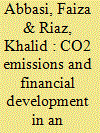

|
|
|
|
|
| Summary/Abstract |
This paper explores the influence of economic and financial development on carbon emissions in a small emerging economy. The study employs ARDL approach to investigate the long run relationship between carbon emissions and a set of economic and financial variables, an Error Correction Model (ECM) to capture the short run dynamics, Granger causality in an augmented VAR framework to check the causality direction, and variance decomposition based on an estimated Vector Error Correction Model (VECM) to determine the relative contributions of economic and financial variables to the evolution of per capita carbon emissions. The periods considered were the full sample (1971–2011), and a reduced sample sub-period (1988–2011) that corresponded to greater liberalization and financial sector development. The financial variables played a role in emission mitigation only in the latter period where greater degree of liberalization and financial sector development occurred. Even then the relative magnitude of emissions mitigation attributable to financial variables was much smaller compared to the emissions raising impact of rising per capita incomes. This underscores the need for adopting other mitigation policies for reducing carbon footprints in those emerging economies where a sufficient degree of financial deepening and financial sector development has not yet taken place.
|
|
|
|
|
|
|
|
|
|
|
|
|
|
|
|
| 3 |
ID:
133455
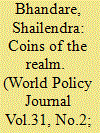

|
|
|
|
|
| Publication |
2014.
|
| Summary/Abstract |
OXFORD, England-We live in a globalized world where financial developments in one region can have an impact on a vastly different and geographically disparate location. The forces joining them are those of money, wealth, and finance, which are deeply interlinked, or so we tend to think. But the world around us has always been globalized, albeit to different degrees and involving different shades of financial undercurrents. An interesting prism to see this continual globalization is through the role itinerant and global currencies and monetary unions have played.
Money is often defined as "as any object (or record of that object) which is regularly used to make payments according to a law which guarantees its value and ensures its acceptability." Acceptance is thus at the core of any particular object being used as money. The spread of monetary traditions across regions happens because people from diverse locations accept particular monies, in the form of coins, paper, or other instruments, to make payments. The fact that coins can circulate as monetary objects greatly enhances their utility. They enable money to be spent and saved by facilitating their division.
|
|
|
|
|
|
|
|
|
|
|
|
|
|
|
|
| 4 |
ID:
169748
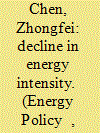

|
|
|
|
|
| Summary/Abstract |
Global energy intensity has decreased significantly during the past two decades. Against this background, this study aims to investigate a novel relationship between development of the financial system (financial development) and energy intensity and explore the underlying mechanisms influencing the relationship between these two indicators. Using long-term country-level data and a two-way fixed-effect model, this study reveals that financial development exerts a significant negative effect on energy intensity for non-OECD countries. However, financial development has a limited impact on energy reduction for OECD countries as a result of the mature financial systems of these developed economies. The estimated results are robust for various specifications. In addition, we reveal a U-shaped relationship between financial development and energy intensity in developing countries. Our results suggest that the influence of financial development on energy intensity reduction can be achieved through technological progress and innovation. Our findings suggest that stimulating financial development is an efficient way to reduce national energy intensity, and specific long-term policies must be established in order to balance the trade-off between financial development, economic growth, and energy intensity.
|
|
|
|
|
|
|
|
|
|
|
|
|
|
|
|
| 5 |
ID:
141818
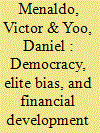

|
|
|
|
|
| Summary/Abstract |
Does democracy induce financial development? There are good theoretical reasons to believe this to be the case, but the evidence adduced to support this claim has been mixed. In this article, the authors posit that only democracies that appeal to the median voter should experience financial development because those democracies have adopted their own constitution after transition, rather than having inherited one from an authoritarian predecessor. The authors empirically test this theory by focusing attention on Latin America, where there have been several reversals and improvements in financial outcomes and where many countries have cycled between regime types. They find robust support for it across different specifications. While popular democracies tend to reform their financial systems, have greater participation in the banking system, increase the supply of credit and reduce its price, and grow their stock markets, elite-biased democracies do not.
|
|
|
|
|
|
|
|
|
|
|
|
|
|
|
|
| 6 |
ID:
192853


|
|
|
|
|
| Summary/Abstract |
This paper describes the growth of local-currency bond markets in Emerging Asia and the institutional and policy challenges facing the region's economies for their further development. It presents an empirical analysis of the relationship between local-currency government bond (LCGB) market development and the components of financial development, using panel data for selected Emerging Asian economies. The analysis seeks to identify the key determinants for the development of LCGB markets. The results show that the depth of and access to both financial markets and financial institutions have a significantly positive impact on LCGB market development. Critical factors associated with local-currency bond market depth include macroeconomic variables, the exchange-rate regime, capital account openness and creditor rights. Based on these results, the paper offers policy directions for fostering the development of local-currency bond markets in the region.
|
|
|
|
|
|
|
|
|
|
|
|
|
|
|
|
| 7 |
ID:
143431
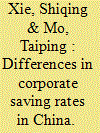

|
|
|
|
|
| Summary/Abstract |
Using the data of the listed non-financial companies from 2003 to 2012, this paper conducts a firm-level empirical analysis to reveal the determinants that lead to differences in saving rates of different enterprises in China. Particularly, we explore the discrepancies in the Chinese enterprises' saving rates from the new perspectives of ownership type, monopoly status, and financial development. We find that only some financial indicators of a firm, including the size and the long-term solvency ability, have direct impact on its saving rate. Besides, the difference in the saving rates between private firms and state-owned firms is insignificant while monopolies have higher saving rates than non-monopolies. Most importantly, financial development generally reduces a firm's saving rate and the impact is independent on its ownership type and monopoly status. Moreover, financial development decreases the influence of a firm's short-term solvency and profitability on its saving rate.
|
|
|
|
|
|
|
|
|
|
|
|
|
|
|
|
| 8 |
ID:
169051
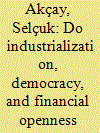

|
|
|
|
|
| Summary/Abstract |
This study aims to unweil the determinants of financial development, particularly the impact of industrialization, democracy, and financial openness on financial development in Turkey over the 1975–2015 period, using a bounds testing approach. It is found that (i) financial development and its main determinants are co-integrated; (ii) democracy is positively associated with financial development, whereas financial openness is associated with lower financial development; and (iii) industrialization is not a significant determinant of financial development in Turkey. Based on the obtained results, some recommendations are also provided.
|
|
|
|
|
|
|
|
|
|
|
|
|
|
|
|
| 9 |
ID:
151709


|
|
|
|
|
| Summary/Abstract |
We examine how armed conflict effects financial development in a cross-country setting using dynamic panel data analysis in a panel of 66 developing countries for the period 1985–2010. Financial development is measured by M2 as a share of GDP, and credit allocated to private sector by banks as a share of GDP. Our findings suggest that armed conflict has a significant adverse effect on financial development. Simultaneously, the quality of governance is always highly significant and conducive to the financial development. The quality of governance is more salient in determining financial development compared to low- and medium-intensity armed conflict; however, the quality of governance cannot entirely offset the adverse impact of high-intensity armed conflict on financial development.
|
|
|
|
|
|
|
|
|
|
|
|
|
|
|
|
| 10 |
ID:
111100
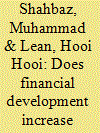

|
|
|
|
|
| Publication |
2012.
|
| Summary/Abstract |
This paper assesses the relationship among energy consumption, financial development, economic growth, industrialization and urbanization in Tunisia from 1971 to 2008. The autoregressive distributed lag bounds testing approach to cointegration and Granger causality tests is employed for the analysis. The result confirms the existence of long-run relationship among energy consumption, economic growth, financial development, industrialization and urbanization in Tunisia. Long-run bidirectional causalities are found between financial development and energy consumption, financial development and industrialization, and industrialization and energy consumption. Hence, sound and developed financial system that can attract investors, boost the stock market and improve the efficiency of economic activities should be encouraged in the country. Nevertheless, promoting industrialization and urbanization can never be left out from the process of development. We add light to policy makers with the role of financial development, industrialization and urbanization in the process of economic development.
|
|
|
|
|
|
|
|
|
|
|
|
|
|
|
|
| 11 |
ID:
088049


|
|
|
|
|
| Publication |
2009.
|
| Summary/Abstract |
A vast number of studies addressed the environmental degradation and economic development but not financial development. Moreover, as argued by Stern [2004. The rise and fall of the environmental Kuznets curve. World Development 32, 1419-1439] they present important econometric weaknesses. Using standard reduced-form modeling approach and controlling for country-specific unobserved heterogeneity, we investigate the linkage between not only economic development and environmental quality but also the financial development. Panel data over period 1992-2004 is used. We find that both economic and financial development are determinants of the environmental quality in BRIC economies. We show that higher degree of economic and financial development decreases the environmental degradation. Our analysis suggests that financial liberalization and openness are essential factors for the CO2 reduction. The adoption of policies directed to financial openness and liberalization to attract higher levels of R&D-related foreign direct investment might reduce the environmental degradation in countries under consideration. In addition, the robustness check trough the inclusion of US and Japan does not alter our main findings.
|
|
|
|
|
|
|
|
|
|
|
|
|
|
|
|
| 12 |
ID:
125664


|
|
|
|
|
| Publication |
2013.
|
| Summary/Abstract |
This paper explores the effects of financial development, economic growth, coal consumption and trade openness on environmental performance using time series data over the period 1965-2008 in case of South Africa. The ARDL bounds testing approach to cointegration has been used to test the long run relationship among the variables while short run dynamics have been investigated by applying error correction method (ECM). The unit root properties of the variables are examined by applying Saikkonen and Lütkepohl (2002. Econometric Theory 18, 313-348) structural break unit root test. Our findings confirmed long run relationship among the variables. Results showed that a rise in economic growth increases energy emissions, while financial development reduces it. Coal consumption has significant contribution to deteriorate environment in South African economy. Trade openness improves environmental quality by reducing the growth of energy pollutants. Our empirical results also verified the existence of environmental Kuznets curve. This paper opens up new insights for South African economy to sustain economic growth by controlling environment from degrdation through efficient use of energy.
|
|
|
|
|
|
|
|
|
|
|
|
|
|
|
|
| 13 |
ID:
183583


|
|
|
|
|
| Summary/Abstract |
Economic development accelerates the process of industrialization that has amplified the worth of extracted natural resources. Extensive exploitation of natural resources through total reserves, financial development, and renewable energy can influence the atmosphere. In view of this, this study examines the influence of industrialization, total reserves and the expansion of financial, renewable and natural resources on the ecological footprint. This research applies panel data for the period from 1990 to 2019 in newly industrialized countries. The findings of the augmented mean group (AMG) panel algorithm are robust to heterogeneity, and cross-sectional dependence points to the heterogeneous effect of industrialization, total reserves and financial development in significantly driving environmental pollution in these countries. In contrast, the abundance of natural resources and renewable energy significantly mitigates environmental pollution in the long-run. These results are also consistent with long-run and disaggregate level estimation. Moreover, the panel Dumitrescu and Hurlin causality test results revealed a unidirectional causality association from industrialization and renewable energy to ecological footprint and from ecological footprint to natural resources. A bidirectional causality relation was also found between financial development and total reserves, and the ecological footprint. Finally, several important policy implications are suggested to protect environmental quality in newly industrialized countries.
|
|
|
|
|
|
|
|
|
|
|
|
|
|
|
|
| 14 |
ID:
186390


|
|
|
|
|
| Summary/Abstract |
This research assesses the importance of financial access on value added in three economic sectors in 25 countries in Sub-Saharan Africa using data for the period 1980–2014. The empirical evidence is based on the Generalized Method of Moments. Financial access is measured with private domestic credit, while the three outcome variables are: value added in the agricultural, manufacturing, and service sectors, respectively. Enhancing financial access does not significantly improve value added in the agricultural and manufacturing sectors, while enhancing financial access improves value added in the service sector. An extended analysis shows that, in order for the positive net incidence of enhancing credit access on value added to the service sector to be maintained, complementary policies are required when domestic credit to the private sector is between 77.50 percent and 98.50 percent of GDP. Policy implications are discussed.
|
|
|
|
|
|
|
|
|
|
|
|
|
|
|
|
| 15 |
ID:
077187


|
|
|
|
|
| Publication |
2007.
|
| Summary/Abstract |
The financial intermediation-growth nexus is a widely studied topic in the literature of development economics. Deepening financial intermediation may promote economic growth by mobilizing more investments, and lifting returns to financial resources, which raises productivity. Relying on provincial panel data from China, this paper attempts to examine if regional productivity growth is accounted for by the deepening process of financial development. Towards this end, an appropriate measurement of financial depth is constructed and then included as a determinant of productivity growth. It finds that a significant and positive nexus exists between financial deepening and productivity growth. Given the divergent pattern of financial deepening between coastal and inland provinces, this finding also helps explain the rising regional disparity in China
|
|
|
|
|
|
|
|
|
|
|
|
|
|
|
|
| 16 |
ID:
110444


|
|
|
|
|
| Publication |
2012.
|
| Summary/Abstract |
This article examines the relationship between financial development and economic growth. Money supply and loans relative to Gross Domestic Product (GDP) are used as indicators of financial development. The empirical results, that money supply leads economic growth while economic growth leads loans, reflect the characteristics of the Russian economy. Oil price increases and the appreciation of the ruble increased money supply under insufficient sterilisation instruments, which, in turn, fostered economic growth. On the other hand, the Russian economic boom provided an incentive for banks to increase loans and their role in initiating economic growth is limited.
|
|
|
|
|
|
|
|
|
|
|
|
|
|
|
|
| 17 |
ID:
169905
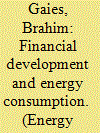

|
|
|
|
|
| Summary/Abstract |
This paper examines the relationship between financial development and energy consumption estimations in the major MENA countries (Algeria, Bahrain, Egypt, Iran, Iraq, Israel, Jordan, Kuwait, Lebanon, Libya, Morocco, Oman, Qatar, Saudi Arabia, Syria, Tunisia, United Arab Emirates and Yemen) over the period 1996 to 2014. We consider the energy use in kg of oil equivalent per capita as a dependent variable that reflects the cross-country energy consumption. We measure the level of financial development in the MENA countries by considering banking indicators. Extending the model of Sadorsky (2011), we estimate both linear and non-linear dynamic panel model. We use new robust econometrics to take into account heterogeneity and nonlinearity and we control the estimation results for the period of the global financial crisis. The results of the study report a positive and statistically significant relationship between the intermediation capacity of the banking system as well as its size and energy consumption. The findings also confirm a non-linear and inverted U-shaped relationship between financial development and energy demand for the MENA region. This implies that initially energy demand increases with financial development and then, at a turning point of financial development, it declines. The policy implications of these results are discussed.
|
|
|
|
|
|
|
|
|
|
|
|
|
|
|
|
| 18 |
ID:
149903


|
|
|
|
|
| Summary/Abstract |
The present paper re-examines the asymmetric impact of financial development on environmental quality in Pakistan for the period 1985Q1 to 2014Q4. A comprehensive index of financial development is generated using Bank- and Stock market-based financial development indicators. The results show that inefficient use of energy adversely affects the environmental quality. This suggests adoption of energy efficient technology at both production and consumption levels. These technologies would be helpful to improve environmental quality, enhance the productivity in long-run and save energy. Bank-based financial development also impedes the environment. The government should encourage lenders to ease the funding for energy sector and allocate financial resources for environment friendly businesses rather than wasting them in consumer financing.
|
|
|
|
|
|
|
|
|
|
|
|
|
|
|
|
| 19 |
ID:
079935


|
|
|
|
|
| Publication |
2007.
|
| Summary/Abstract |
Financial sector development may contribute to economic growth by facilitating capital accumulation and by improving productivity. This article investigates empirically the contribution that financial development may make to these two alternative drivers of economic growth in China using annual data for the period 1952 to 2005. Using cointegration and Granger-causality testing we examine the relationship between financial development and, respectively, capital accumulation and productivity in a time-series vector autoregression (VAR) framework. The substantive findings are that there is either bi-directional Granger causality between financial development and capital accumulation or that Granger causality runs from capital accumulation to financial development, depending on how capital accumulation and financial development are measured. The link between financial development and productivity is found to be statistically weak
|
|
|
|
|
|
|
|
|
|
|
|
|
|
|
|
| 20 |
ID:
066647
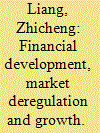

|
|
|
|
|
|
|
|